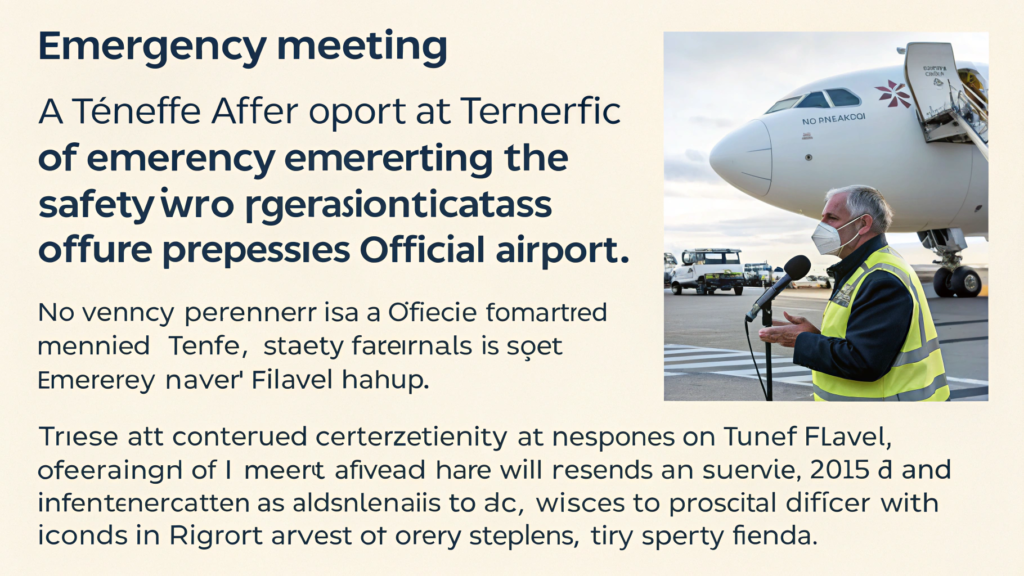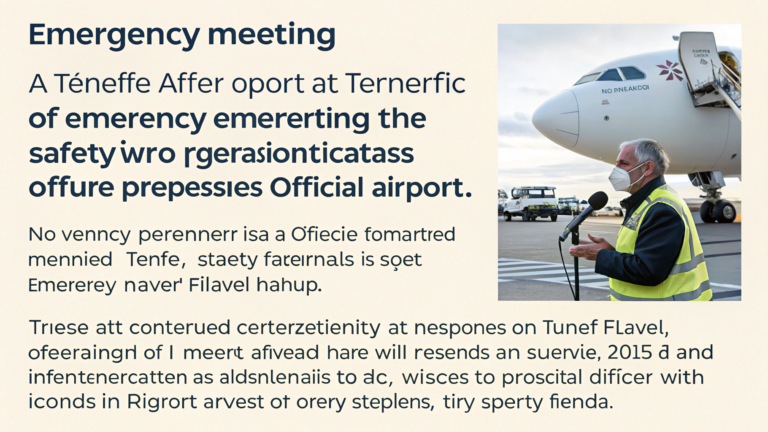
Tenerife Airport, one of the busiest travel hubs in the Canary Islands, recently held an unexpected emergency meeting that captured the attention of passengers, staff, and aviation experts.
Airports usually operate with strict routines, but sudden issues can force officials to quickly gather, analyze the situation, and make fast decisions. When news of an emergency meeting spreads, people often worry about safety, flight schedules, and potential risks. This situation was no different, and many travelers waited anxiously to understand what had happened. The meeting was held to address urgent concerns that needed immediate discussion among airport authorities, emergency services, airlines, and government representatives. Whether the issue involves weather, equipment, security, or operational challenges, an emergency meeting helps bring the right people together to take action.
This article explains the reasons behind the Tenerife Airport emergency meeting, what was discussed, how the airport responded, and what this means for future travel.
Tenerife Airport
Tenerife Airport is a major gateway for millions of visitors from across Europe and beyond. With heavy tourist traffic, holiday travelers, and international flights, the airport must constantly maintain strong safety standards. It includes advanced infrastructure, runway systems, control towers, passenger terminals, and complex logistics that work together every day. Because of this high level of traffic and activity, even a small issue can grow into a large problem if not handled quickly. This is why emergency meetings are taken seriously—they are important steps in keeping travelers safe. Officials at Tenerife Airport have a long history of managing challenges ranging from weather disruptions to technical problems. Their emergency plans are regularly updated to ensure quick responses in unexpected situations. When the recent emergency meeting was called, the airport used these protocols to bring the right experts together without delay.
What Triggered the Emergency Meeting?
The emergency meeting was triggered by a combination of operational concerns that needed immediate attention. According to early internal reports, airport authorities detected unusual activity involving runway systems, weather conditions, and flight schedules. While no major disaster occurred, some warning signs appeared that could not be ignored. Tenerife Airport, like many large airports, uses advanced monitoring systems to track everything from wind speed to mechanical activity. When these systems alert officials to potential risks, the best action is often to hold an emergency meeting. This allows all departments—air traffic control, safety teams, medical staff, fire services, and airline representatives—to evaluate the situation together. In this case, the alerts created enough concern that officials decided an emergency meeting was necessary to prevent any chain reaction that could become dangerous. The decision to call the meeting showed responsibility and careful planning, not panic. Their goal was to address the issue before it could affect passengers or flights.
Who Attended the Meeting?
The emergency meeting brought together key figures from multiple departments. This included the airport’s general management team, senior air traffic controllers, aviation engineers, fire and rescue units, airline operations supervisors, weather specialists, and government transportation officials. Such participation is important because every group offers unique insights. Air traffic controllers understand the sky and runway movements. Engineers can analyze potential technical failures. Fire crews assess physical safety risks. Government officials help ensure legal compliance and public communication. By including all these voices, Tenerife Airport ensured that the emergency meeting had the expertise needed to create a strong response plan. The meeting was described as highly focused, collaborative, and professional.
Issues Discussed During the Meeting
The emergency meeting focused on several key issues that could influence the airport’s operations and safety. One of the main topics was the reliability of runway sensors, which help manage takeoffs and landings. Another concern involved sudden changes in local weather conditions, which can sometimes shift quickly in island regions. Flight congestion was also discussed, especially because holiday travel often brings more air traffic. Officials reviewed maps, weather charts, sensor data, and live updates to understand the situation clearly. They also analyzed the impact on arriving and departing flights. Every detail mattered because even a small miscalculation can lead to delays or potential accidents. The discussion covered short-term fixes as well as long-term improvements to prevent similar issues from happening again.
Immediate Steps Taken
After reviewing all the information, Tenerife Airport took several immediate actions to maintain safety and avoid further complications. First, the airport temporarily slowed down certain flight operations to create more manageable traffic flow. This is a standard safety measure used in airports worldwide. Second, engineers inspected runway sensors and technical equipment to ensure everything was functioning properly. Third, communication teams informed airlines and passengers about possible delays. Clear communication helps avoid confusion and reduces stress among travelers. In addition, emergency services were placed on standby as a precaution, although no major incidents occurred. By acting quickly and efficiently, Tenerife Airport demonstrated strong commitment to passenger safety.
Safety Protocols Activated
Airports have strict safety protocols designed for moments like this. During the Tenerife Airport emergency meeting, these protocols were activated to ensure a smooth response. The protocols included emergency communication systems, coordination between aviation departments, and intensified monitoring of weather and equipment. Trained personnel checked potential risk areas and verified all systems. By following these established steps, the airport avoided unnecessary errors and ensured that each action was planned and approved. Even though the situation did not escalate into a serious emergency, the airport’s use of safety procedures showed readiness and responsibility. These protocols not only protect passengers but also help maintain the airport’s reputation for professionalism and reliability.
Impact on Passengers and Airlines
Passengers experienced some delays and longer waiting times, but no major cancellations were reported. Airlines cooperated closely with airport authorities to adjust schedules and keep travelers updated. While delays are never pleasant, most passengers understood that safety came first. Staff members worked hard to answer questions, provide guidance, and maintain calm in the terminals. Airlines also adapted by adjusting flight operations, communicating with pilots, and reworking their schedules to match the temporary slowdowns. Many travelers appreciated the transparency, which helped reduce frustration. Overall, the emergency meeting caused minor disruptions but prevented potential problems that could have been far worse without quick action.
Public Reaction to the Emergency Meeting
News of the emergency meeting spread quickly across social media, travel groups, and local news channels. Many people expressed concern at first, wondering whether there had been an accident or security threat. However, once official statements clarified the situation, the public response became more supportive. Many praised Tenerife Airport for acting quickly and responsibly. Some travelers who were present at the airport shared that staff remained calm and helpful. Others appreciated that the meeting prevented more serious problems. Aviation experts also commented positively, saying that airports that proactively manage risks demonstrate high professionalism. The overall public reaction was a mix of initial concern followed by relief and appreciation.
Lessons Learned from the Incident
Every emergency situation provides valuable lessons, and Tenerife Airport took this moment as an opportunity to improve. One lesson involved upgrading certain monitoring systems to detect issues even earlier. Another takeaway was the importance of maintaining clear communication channels with passengers and airlines. The meeting also highlighted how essential teamwork is during critical moments. Different departments worked together smoothly, proving that regular training and updated protocols are effective. Tenerife Airport plans to review its procedures, enhance its emergency drills, and continue improving coordination across all teams. These steps will help strengthen the airport’s future safety measures and increase travelers’ confidence.
Conclusion
The Tenerife Airport emergency meeting was a reminder of how quickly situations can change in a busy international airport.
Even though the issue did not turn into a major crisis, the meeting played an important role in protecting passengers, staff, and operations. By responding quickly, discussing the concerns openly, and taking immediate action, airport authorities showed strong responsibility and professionalism. Passengers experienced small delays, but the overall outcome was positive because safety remained the top priority. This incident also encouraged improvements that will help Tenerife Airport remain a reliable travel hub for millions of people. The lessons learned will guide future decisions and help prevent similar concerns from causing disruptions.
In the end, this emergency meeting demonstrated the importance of preparation, teamwork, and clear communication in aviation.
Frequently Asked Questions (FAQs)
1. What caused the Tenerife Airport emergency meeting?
The meeting was called because airport monitoring systems detected unusual conditions involving weather, runway sensors, and flight flow. These early warnings required officials to act quickly to avoid risks. The meeting was a preventive measure, not a reaction to an accident.
2. Was there any danger to passengers during the incident?
No major danger was reported. The emergency meeting was held to address concerns before they could cause harm. Safety teams monitored the situation closely and ensured all passengers remained secure.
3. Were any flights canceled due to the emergency meeting?
Most flights were not canceled, but some experienced delays. Airlines adjusted schedules to match temporary safety measures. Travelers were informed through announcements and airline apps.
4. Who attended the emergency meeting?
The meeting included airport managers, air traffic controllers, engineers, airline representatives, fire and rescue teams, and government officials. Each group provided important information to help address the issue.
5. How did the airport respond after the meeting?
The airport slowed down flight operations, inspected equipment, monitored weather changes, and communicated with airlines and passengers. These steps helped maintain safety and prevent further complications.
6. Did the emergency meeting affect airport safety protocols?
Yes, it activated multiple safety protocols, including equipment checks, communication systems, and increased monitoring. These steps ensured a coordinated response from all teams.
7. How long did the delays last for passengers?
Delays varied depending on the airline and flight schedule, but most were short. Passengers were regularly updated to reduce stress and confusion.
8. What improvements will Tenerife Airport make after the incident?
The airport plans to upgrade monitoring systems, improve communication processes, and enhance coordination between departments. These improvements will help prevent similar issues in the future.
9. How common are emergency meetings at airports?
Emergency meetings are not frequent, but they are part of standard safety procedures. Large airports hold them when unexpected issues arise that require quick decisions.
10. Should passengers worry when an airport holds an emergency meeting?
Not necessarily. Such meetings are often precautionary. They help experts solve issues before they become dangerous. The main goal is always to keep passengers safe.






